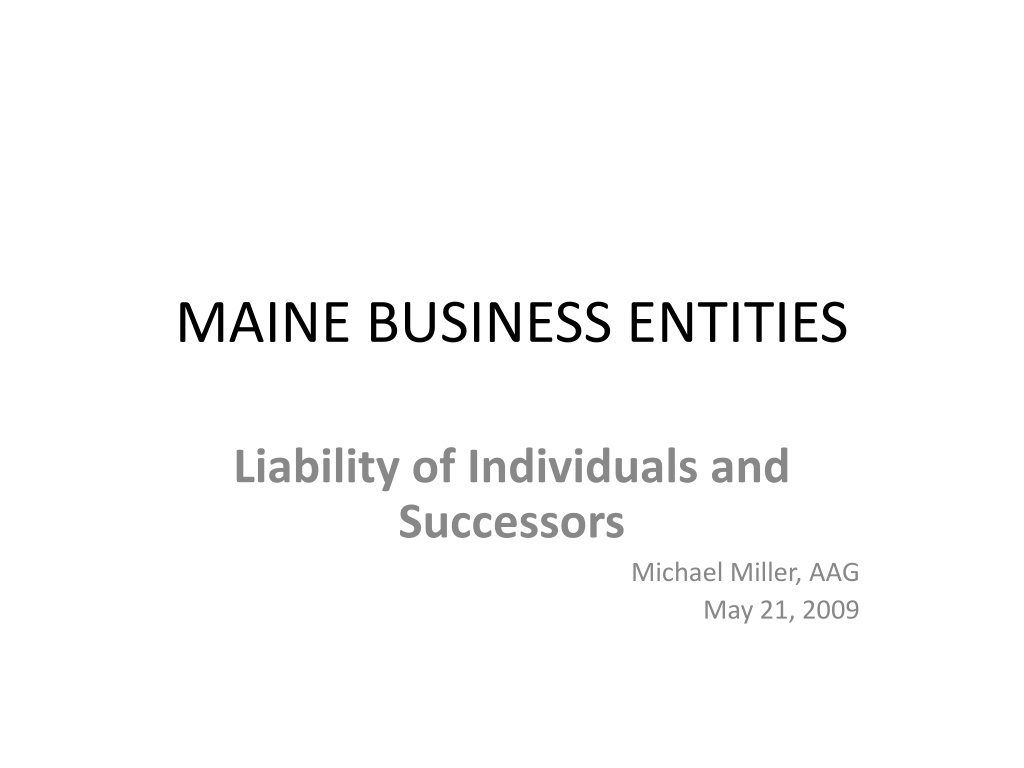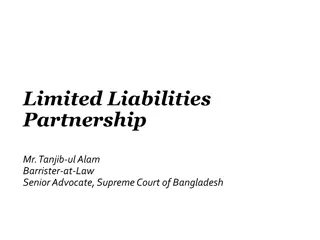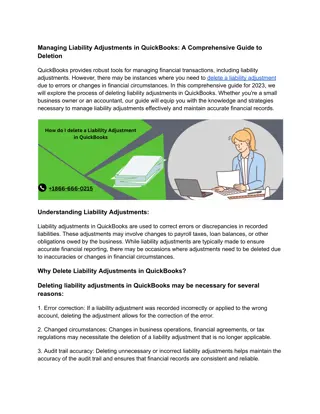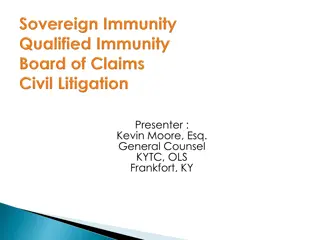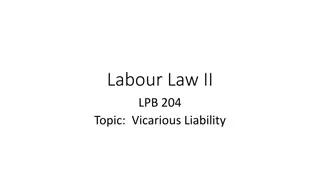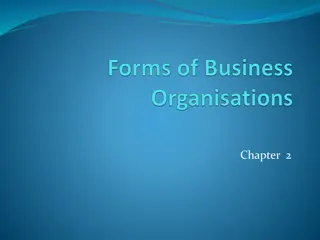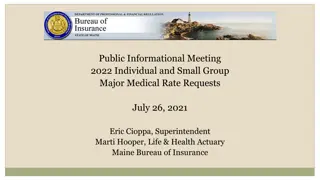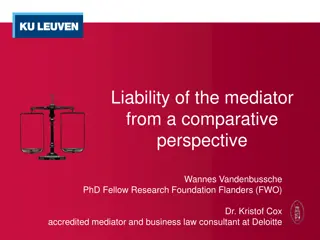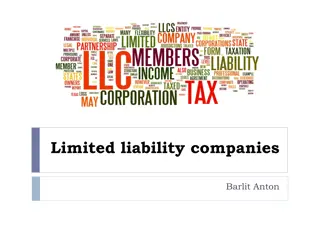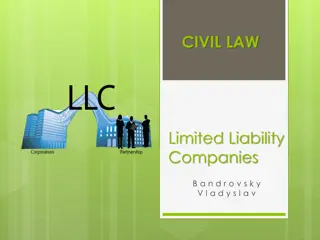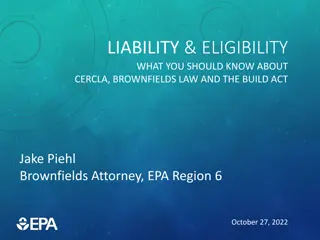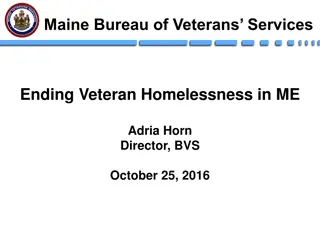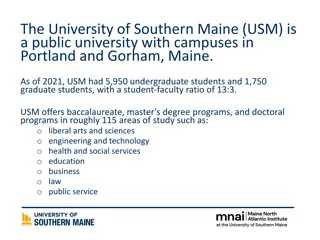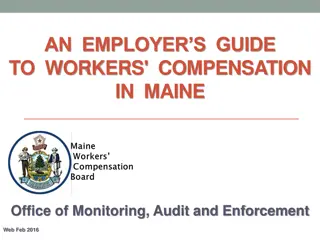Understanding Liability of Individuals in Maine Business Entities
Maine business entities, including corporations and LLCs, offer limited liability protections for owners and managers. Shareholders of corporations are not personally liable for the entity's debts, except in specific circumstances. Similarly, members and managers of LLCs are not personally obligated for the company's liabilities, unless specified otherwise. The concept of piercing the corporate veil is a doctrine that allows courts to disregard the legal entity in certain situations of abuse or injustice.
Download Presentation

Please find below an Image/Link to download the presentation.
The content on the website is provided AS IS for your information and personal use only. It may not be sold, licensed, or shared on other websites without obtaining consent from the author. Download presentation by click this link. If you encounter any issues during the download, it is possible that the publisher has removed the file from their server.
E N D
Presentation Transcript
MAINE BUSINESS ENTITIES Liability of Individuals and Successors Michael Miller, AAG May 21, 2009
Personal Liability General Rule: Corporations and LLCs are separate legal entities with statutorily derived limited liability protections for owners and those that manage the entity
Cant touch this CORPORATIONS SHAREHOLDERS DIRECTORS OFFICERS LIMITED LIABILITY COMPANIES (LLCs) MEMBERS MANAGERS
Personal Liability Unless otherwise provided in a corporation s articles of incorporation, a shareholder of a corporation is not personally liable for the acts or debts of the corporation except that the shareholder may become personally liable by reason of the shareholder s acts or conduct. 13-C M.R.S. 623(2)
Personal Liability Except as otherwise provided in this Act, the debts, obligations and liabilities of a limited liability company, whether arising in contract, tort or otherwise, are solely the debts, obligations and liabilities of the limited liability company. A member or manager of a limited liability company is not obligated personally for any such debt, obligation or liability of the limited liability company solely by reason of being a member or acting as a manager of a limited liability company. 31 M.R.S. 645(1)
Piercing the Corporate Veil Piercing the Corporate Veil is an equitable doctrine that attempts to balance the public policies of encouraging business development with protecting those who deal with the corporation. Johnson v. Exclusive Properties Unlimited, 1998 ME 244, 720 A.2d 568
Piercing the Corporate Veil Courts are hesitant to disregard the legal entity Will do so only when necessary to promote justice
Piercing the Corporate Veil Plaintiff must establish: 1) That the defendant abused the privilege of a separate corporate existence some manner of dominating, abusing, or misusing the corporate form; and 2) An unjust or inequitable result would occur if the court recognized the separate existence. Johnson, 1998 ME 244, 6
Piercing the Corporate Veil First Prong: Abuse of the privilege of separate corporate existence may be evidenced by twelve factors: 1) Common ownership 2) Pervasive control
Piercing the Corporate Veil 3) Confused intermingling of business activity, assets or management 4) Thin capitalization 5) Nonobservance of corporate formalities
Piercing the Corporate Veil 6) Absence of corporate records 7) No payment of dividends 8) Insolvency at the time of the litigated transaction
Piercing the Corporate Veil 9) Siphoning away of corporate assets 10) Nonfunctioning of officers and directors 11) Use of corporation for transactions of the dominant shareholders 12) Use of the corporation in promoting fraud
Piercing the Corporate Veil Fraud is not a prerequisite to piercing the corporate veil. While a finding of fraud can make it easier to find that there has been an abuse of the privilege of a separate corporate identity, there could be a finding of abuse without fraud. Advanced Construction Corporation v. Pilecki, 2006 ME 84, 901 A.2d 189
Piercing the Corporate Veil Second Prong: An unjust or inequitable result would occur if the court recognized the separate corporate existence Does not require a finding of fraud or illegality. Could be to prevent injustice or inequitable consequences. Johnson, 1998 ME 244, 8
Piercing the Corporate Veil When attempting to pierce the corporate veil in the context of a contractual relationship, courts should apply more stringent standards because the party seeking relief is presumed to have voluntarily and knowingly entered into an agreement with a corporate entity and is expected to suffer the consequences of the limited liability associated with the corporate business form. Alternative Nursing Care, Inc. v. C.H. Wright, Inc., 2003 Me. Super. LEXIS 114, Crowley, J. (Jun. 3, 2003
Piercing the Corporate Veil Application to Limited Liability Companies Mowles v. Predictive Control System, LLC, 2002 Me. Super. LEXIS 190, Cole, J. (Oct. 22, 2002)
Piercing the Corporate Veil 31 M.R.S. 645(3): The exceptions under the common law to the limited liability of shareholders of a business corporation organized under the Maine Business Corporation Act and shareholders of a professional corporation organized under the Maine Professional Service Corporation Act apply to the limited liability of members of a limited liability company
Wrongful Act of Corporate Officer Corporate officers who participate in wrongful acts can be held liable for their individual acts, and such liability is distinct from piercing the corporate veil. Advanced Construction Corporation v. Pilecki, 2006 ME 84, 901 A.2d 189
Wrongful Act of Corporate Officer Officer personally participating in the wrongful act cannot use the corporation to shield himself Must show direct personal involvement by the officer in some decision or action which is causally related to the injury or harm
Wrongful Act of Corporate Officer Application to Limited Liability Companies Weber v. U.S. Sterling Securities, Inc., 924 A.2d 816 (Conn. 2007)
Tortious Conduct of Agent In an action for the tortious conduct of an agent, both the agent and the principal may be held liable. Advanced Construction, 2006 MR 84, 16
Agency-Undisclosed Principal An agent who makes a contract for an undisclosed principal or a partially disclosed principal will be liable as a party to a contract. Treadwell v. J.D. Construction Co., 2007 ME 150, 938 A.2d 794
CRIMINAL LIABILITY An individual is criminally liable for any conduct the individual performs in the name of an organization or in its behalf to the same extent as if it were performed in the individual's own name or behalf. 17-A M.R.S. 61(1)
CRIMINAL LIABILITY If a criminal statute imposes a duty to act on an organization, any agent of the organization having primary responsibility for the discharge of the duty is criminally liable if the agent recklessly omits to perform the required act . 17-A M.R.S. 61(2)
Responsible Corporate Officer Doctrine Limited Application: Strict liability A responsible share or responsible relationship Defendant has by reason of position in the corporation, responsibility and authority either to prevent in the first instance, or promptly to correct, the violation complained of, and that he/she failed to do so
Personal Liability Remember to Look for Statutory Bases for Liability
Successor Liability General Rule: A corporation that purchases the assets of another corporation in a bona fide arm s-length transaction is not liable for the debts of the transferor corporation.
Successor Liability Bases: 1) Successor agrees either expressly or impliedly to assume liabilities of the predecessor 2) Transaction accomplished through merger or consolidation and becomes liable by operation of law
Successor Liability 3) Transaction is fraudulent attempt to escape obligations of predecessor 4) Transaction is a sham Mere continuation doctrine De facto merger doctrine
Successor Liability Product Line Doctrine Continuity of the Enterprise Doctrine
Successor Liability Remember to look for statutory bases of liability
Maine Business Entities Thank you
